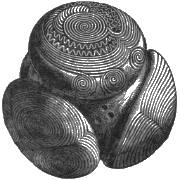NMS Archaeology Object 136276: X.FRA 695 - Spoon
Description
Summary
Spoon or cochleare of bronze, for eating eggs, shellfish and snails, from the Roman site at Newstead, Roxburghshire, 80 - 180 AD
Accession Number
X.FRA 695
Other references
| Not recorded | I16.5 |
|---|
Original description
NEWSTEAD COLLECTION. Small spoon of copper which appears to have been coated with white metal, 4 3/4" in extreme length; the bowl measures 7/8" in diameter, & the handle is pointed to the end. [MoS description] Fat of the land. Roman utensils - officers. (8) Bronze spoons for eating eggs, shellfish and snails, Newstead. 80 - 180 AD. [Scran caption] This bronze spoon was found at the site of the Roman fort at Newstead in Roxburghshire. It dates from between 80 and 180 AD. Roman spoons of this shape are known as 'cochleare' in Latin. The spoon has a small circular bowl and a long and slender handle which is pointed to the end. It appears to have been coated with white metal, presumably to make it appear like silver. Excavations at Newstead have revealed much about the layout and daily life in Roman forts in Scotland. Officers in the Roman army possessed better cooking and serving equipment than the lower ranks. Date: Between 80 and 180 AD. Material: Bronze. Dimensions: Length: 12.1 cm.
Associated person/people (e.g. excavator/former collection)
Newstead Collection
Discovery / field collection
Date of discovery
1905
Method (e.g. excavation)
Excavated
Place (i.e. location of discovery)
Newstead, Roxburghshire, Scotland, Northern Europe
Grid reference
Not recorded
Acquisition
Acquisition date
1916
Acquisition source (i.e. name of donor)
Unknown
Acquisition source role (e.g. donor)
Not recorded
Image
Identifiers and Links to Other Records
Would you like to help find more links?
| Identifier / External Link | Linked Record | Status | Comment |
|---|---|---|---|
| Canmore Site Id: 55621 | NEWSTEAD - MELROSE - ROMAN FORT (ROMAN) | Definite | |
| NMS Accession Number: X.FRA 695 | No linked record | Identifier supplied by NMS |
This area is visible only to logged in users.
